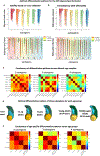Hippocampal anterior- posterior shift in childhood and adolescence
- PMID: 36967075
- PMCID: PMC10185869
- DOI: 10.1016/j.pneurobio.2023.102447
Hippocampal anterior- posterior shift in childhood and adolescence
Abstract
Hippocampal-cortical networks play an important role in neurocognitive development. Applying the method of Connectivity-Based Parcellation (CBP) on hippocampal-cortical structural covariance (SC) networks computed from T1-weighted magnetic resonance images, we examined how the hippocampus differentiates into subregions during childhood and adolescence (N = 1105, 6-18 years). In late childhood, the hippocampus mainly differentiated along the anterior-posterior axis similar to previous reported functional differentiation patterns of the hippocampus. In contrast, in adolescence a differentiation along the medial-lateral axis was evident, reminiscent of the cytoarchitectonic division into cornu ammonis and subiculum. Further meta-analytical characterization of hippocampal subregions in terms of related structural co-maturation networks, behavioural and gene profiling suggested that the hippocampal head is related to higher order functions (e.g. language, theory of mind, autobiographical memory) in late childhood morphologically co-varying with almost the whole brain. In early adolescence but not in childhood, posterior subicular SC networks were associated with action-oriented and reward systems. The findings point to late childhood as an important developmental period for hippocampal head morphology and to early adolescence as a crucial period for hippocampal integration into action- and reward-oriented cognition. The latter may constitute a developmental feature that conveys increased propensity for addictive disorders.
Keywords: Adolescence; Childhood; Hippocampus; Structural covariance.
Copyright © 2023 The Authors. Published by Elsevier Ltd.. All rights reserved.
Conflict of interest statement
Competing interest HRS has received honoraria as speaker from Sanofi Genzyme, Denmark, Lundbeck AS, Denmark, and Novartis, Denmark, as consultant from Sanofi Genzyme, Denmark, Lophora, Denmark, and Lundbeck AS, Denmark, and as editor-in-chief (Neuroimage Clinical) and senior editor (NeuroImage) from Elsevier Publishers, Amsterdam, The Netherlands. HRS has received royalties as book editor from Springer Publishers, Stuttgart, Germany and from Gyldendal Publishers, Copenhagen, Denmark.
Figures



Similar articles
-
Longitudinal hippocampal axis in large-scale cortical systems underlying development and episodic memory.Proc Natl Acad Sci U S A. 2024 Oct 29;121(44):e2403015121. doi: 10.1073/pnas.2403015121. Epub 2024 Oct 22. Proc Natl Acad Sci U S A. 2024. PMID: 39436664 Free PMC article.
-
Hippocampal metabolic subregions and networks: Behavioral, molecular, and pathological aging profiles.Alzheimers Dement. 2023 Nov;19(11):4787-4804. doi: 10.1002/alz.13056. Epub 2023 Apr 4. Alzheimers Dement. 2023. PMID: 37014937 Free PMC article.
-
New insights into anatomical connectivity along the anterior-posterior axis of the human hippocampus using in vivo quantitative fibre tracking.Elife. 2022 Nov 8;11:e76143. doi: 10.7554/eLife.76143. Elife. 2022. PMID: 36345716 Free PMC article.
-
Meta-analytic and functional connectivity evidence from functional magnetic resonance imaging for an anterior to posterior gradient of function along the hippocampal axis.Hippocampus. 2020 May;30(5):456-471. doi: 10.1002/hipo.23164. Epub 2019 Oct 7. Hippocampus. 2020. PMID: 31589003 Review.
-
The many dimensions of human hippocampal organization and (dys)function.Trends Neurosci. 2021 Dec;44(12):977-989. doi: 10.1016/j.tins.2021.10.003. Epub 2021 Oct 27. Trends Neurosci. 2021. PMID: 34756460 Free PMC article. Review.
Cited by
-
Longitudinal hippocampal axis in large-scale cortical systems underlying development and episodic memory.Proc Natl Acad Sci U S A. 2024 Oct 29;121(44):e2403015121. doi: 10.1073/pnas.2403015121. Epub 2024 Oct 22. Proc Natl Acad Sci U S A. 2024. PMID: 39436664 Free PMC article.
-
Discovery, Replicability, and Generalizability of a Left Anterior Hippocampus' Morphological Network Linked to Self-Regulation.Hum Brain Mapp. 2024 Dec 15;45(18):e70099. doi: 10.1002/hbm.70099. Hum Brain Mapp. 2024. PMID: 39705057 Free PMC article.
-
Effects of childhood maltreatment and major depressive disorder on functional connectivity in hippocampal subregions.Brain Imaging Behav. 2024 Jun;18(3):598-611. doi: 10.1007/s11682-024-00859-w. Epub 2024 Feb 7. Brain Imaging Behav. 2024. PMID: 38324083
-
Neural Maturity of Encoding States Supports Gains to Memory Precision in Childhood.Child Dev. 2025 Jun 27;96(5):1852-61. doi: 10.1111/cdev.70003. Online ahead of print. Child Dev. 2025. PMID: 40579774 Free PMC article.
References
-
- Alexander GE, Crutcher MD, & DeLong MR (1990). Basal ganglia-thalamocortical circuits: parallel substrates for motor, oculomotor, “prefrontal” and “limbic” functions. Prog Brain Res, 85, 119–146. - PubMed
-
- Alexander LM, Escalera J, Ai L, Andreotti C, Febre K, Mangone A, Vega-Potler N, Langer N, Alexander A, Kovacs M, Litke S, O’Hagan B, Andersen J, Bronstein B, Bui A, Bushey M, Butler H, Castagna V, Camacho N, Chan E, Citera D, Clucas J, Cohen S, Dufek S, Eaves M, Fradera B, Gardner J, Grant-Villegas N, Green G, Gregory C, Hart E, Harris S, Horton M, Kahn D, Kabotyanski K, Karmel B, Kelly SP, Kleinman K, Koo B, Kramer E, Lennon E, Lord C, Mantello G, Margolis A, Merikangas KR, Milham J, Minniti G, Neuhaus R, Levine A, Osman Y, Parra LC, Pugh KR, Racanello A, Restrepo A, Saltzman T, Septimus B, Tobe R, Waltz R, Williams A, Yeo A, Castellanos FX, Klein A, Paus T, Leventhal BL, Craddock RC, Koplewicz HS, & Milham MP (2017, 2017/December/19). An open resource for transdiagnostic research in pediatric mental health and learning disorders. Scientific Data, 4(1), 170181. 10.1038/sdata.2017.181 - DOI - PMC - PubMed
-
- Amunts K, Kedo O, Kindler M, Pieperhoff P, Mohlberg H, Shah NJ, Habel U, Schneider F, & Zilles K (2005, Dec). Cytoarchitectonic mapping of the human amygdala, hippocampal region and entorhinal cortex: intersubject variability and probability maps. Anat Embryol (Berl), 210(5–6), 343–352. 10.1007/s00429-005-0025-5 - DOI - PubMed

